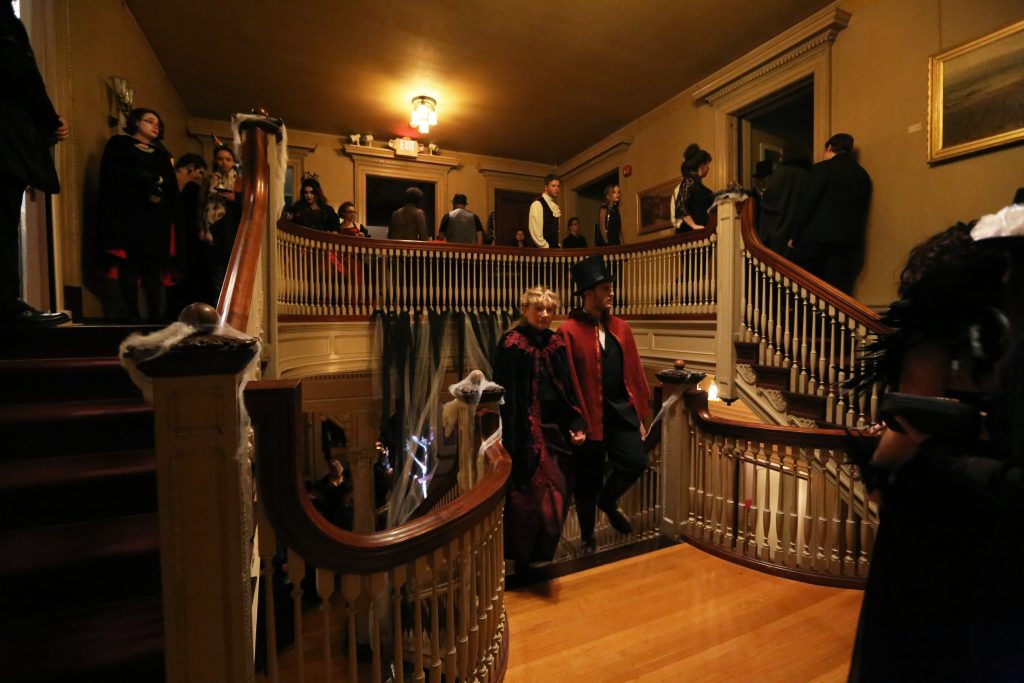From 8 p.m. to midnight on Oct. 26, the Roberson Mansion’s “Dance of the Dead” fundraiser invited guests to partake in an evening of food, drink and supernatural delights inspired by the Victorian macabre. A connoisseur of all things goth, I jumped at the chance to attend.
I arrived a little over half an hour into the party and immediately found myself underdressed in a leather jacket and jeans as Buffy the Vampire Slayer. Partygoers stuck to the theme, sporting crinolines wide enough to part a crowd, more top hats than I could count and dark accents like jeweled canes and black feathers. One guest showed me a rubber crow they had modified into a purse. In one small room, a taxidermied deer and squirrel — perhaps a clue into what morbidity meant to the people who actually lived in the early 20th-century home — loomed over an old desk littered with festive glasses. Kitschy touches like holographic-moving photos clashed with the genuinely eerie air of the mansion itself. I wasn’t hungry and didn’t feel much like drinking, so I passed up the spread of food and the bar on the first floor, which offered specialties like the “Poison Apple and Black Magic Sangria.” A sign reading “curiosities” instead pointed me up the stairs, where I participated in a few Victorian parlor games — an old version of “mafia” and a game where a ring of guests passed a card behind our backs.
Later, I found myself seated before a Ouija board with two ghost hunters. Before we gave it a go, one asked me if I’d ever tried it (I hadn’t) and the other told a story about their own Ouija board disappearing. After a few minutes of chatting, one predicted, “I bet if we all touch this thing, it won’t move.” It didn’t. Once the ghost hunters left, I had a second try with a self-identified medium and two other guests. One looked at the board with weary eyes before we began, concerned that they had too much “baggage” to participate. When we all touched the triangle, I finally felt it move, though I suspected the medium might be helping it along. I’ve read some of the science behind Ouija boards — I’d guessed that the stronger the participants’ convictions, the more likely it is to move. As the movements formed random letter jumbles, “ENS,” “CMAT,” “DABCE” (“dance?”) and “BLUCOX” (“maybe it’s been a while”), the guest who’d been worried about baggage reported a numb feeling in the hand touching the board, which persisted even after they switched hands. I learned a few basic rules: that you’re supposed to have an equal number of women and men at the table, that you can’t rest your arms on the table and that the crucifix I was carrying was possibly damaging our connection with the ghosts.
I briefly stopped at the third-level ballroom and heard Kesha’s “TiK ToK” — unfortunately, not as atmospheric a choice as I was hoping for — while bustled skirts swished across the dance floor. I stayed for only a moment before hurrying down the stairs to catch the 9:45 p.m. séance, one of the three performed that night at times advertised outside the small room where they were held. A line had already formed when I got there 10 minutes early, and after just making it into the room, I was told by the mentalist conducting the séance that we’d be calling on the ghost of Alonzo Roberson. It played out a bit like a magic trick, culminating in a hypnotized audience member correctly choosing the key to a wooden box. The box contained a fishing lure supposedly cherished by Roberson, and the image of the mentalist dangling the lure before the audience is one I won’t soon forget. This particular amalgamation of spirituality and performance didn’t quite agree with me, and I probably won’t be biting the hook anytime soon. I was admittedly a little creeped out, though, later walking down the mansion’s long, secluded hallways and passing the elevator, the most haunted part of the building according to several guests.
Before leaving, I sat to take some notes in the “funeral parlor” on the first floor. A speaker played a recording of Claude Debussy’s “Clair de Lune” near a few rows of chairs, which faced a black coffin decorated with what looked like a horse skull with black flowers pouring from its empty cavities. The seats were empty, save for a few couples chatting and looking through their phones, but at the front, a lone guest in a huge fur coat looked solemnly downward as if at a real wake. The image struck me, maybe because I saw in it the same impulse that had pushed me to spend my Saturday evening in a creepy mansion full of strangers. For each guest who approached the night’s festivities with skeptical lightheartedness, there was surely another who came in search of fulfillment — be it aesthetic, Dionysian or spiritual. As I left the mansion, its green-light-bathed exterior recalling the works of Edgar Allan Poe, Nick Cave or Félicien Rops that I gravitate toward every autumn, I decided I’d found mine.



